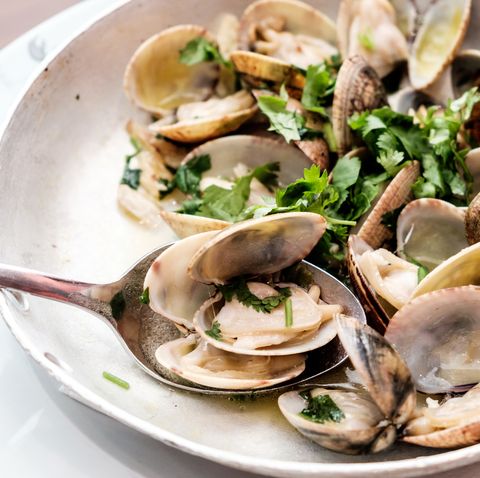YOU ALREADY know that you should be eating more seafood to improve your health.
The USDA’s current dietary guidelines set the goal of at least 8 oz of seafood weekly in order to reap the nutritional benefits.
And, as a registered dietitian, I know these benefits well because I preach them to my clients. Seafood offers lean protein, for a sensible amount of calories, and many varieties are loaded with heart-healthy omega-3 fatty acids, as well as various other vitamins and minerals.
But when it comes to seafood, I’m so tired about hearing about salmon and tuna, salmon and tuna. With shrimp, that trio makes up the most popular seafood in North America.
There’s nothing wrong with salmon and tuna from a nutritional perspective, it’s just that there’s one class of seafood that’s underrated and unsung.
I’m talking about mussels, oysters, clams, scallops and mollusks—bivalves.
Bivalves are loaded with nutrients and protein, offer tons of flavor, and are incredibly sustainable.
“I see canned bivalves as an ultimate win-win” says registered dietitian, Kate Geagan. “Canned mussels, clams, even oysters are for eaters looking for convenient, versatile, healthy proteins that are also sustainable. Each are lower on the food chain, help clean our waterways and create more diverse and resilient coastal ecosystems. Bite for bite, none of the farmed bivalves require any inputs and each offer a bevy of beneficial nutrients such as omega 3s, vitamin B12, zinc and iron.”
But it’s not just the nutrient density of bivalves that makes them winners. Bivalves are like filters for the ocean, cleaning the water, adding oxygen to bottom waters and building protein with the nutrients they take in all while they sequester carbon to build their own shells without needing a single input.
Even more, according to the National Oceanic and Atmospheric Administration, they also help control algal blooms, provide habitats for other marine life, filter excess nitrogen, biotoxins and pathogenic microorganisms from the waters.
They’re like the Supermen of the waterways.
Admittedly, bivalves can be a bit intimidating if you didn’t grow up eating them. And you might think they’re expensive, fancy, or hard to prepare.
So here’s a solution to all that: Try them jarred or canned.
Tossing canned clams into a pasta dish or snacking on smoked mussels with crackers can be easy ways to start incorporating these foods into diet. (Even our 12-year old daughter surprised all of us when, after trying canned mussels, now asks for them regularly as an after-school snack.)
This is also likely thanks to the high-quality and tasty options created by a few craft seafood canneries, one of them being Scout, a company changing the game with crafting chef-inspired, artisan recipes within each can.
Adam Bent, co-founder and CEO of the company discusses how SCOUT is making waves with canned seafood: “Built on the seafood industry’s heritage, where canneries were a staple in coastal fishing communities across North America and local fishermen bring their catch to be preserved, much like a fine charcuterie.”
Or, should we say, SEAcuterie. (Sorry.)
Bivalves offer an overlooked protein for consumers and they’re one of my top picks from a health and sustainability standpoint. If you’re looking for portable, sustainable, and delicious whole-food protein that can make for a fine dining experience or an easy, on-the-go-snack, do like my daughter does and turn to the sea.
This content is created and maintained by a third party, and imported onto this page to help users provide their email addresses. You may be able to find more information about this and similar content at piano.io




Comments are closed.